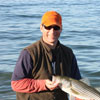Sustainable Fishing for the Future: 5 Tips
By Tom Keer
Nov 11, 2015
I don't envy fisheries managers because they're trying to create sustainable fishing which includes catches for today as well as for the future.
I don't envy fisheries managers because they're trying to create sustainable fishing which includes catches for today as well as for the future. Their difficult task at hand is represented in the old saying of “You can have it right or you can have it now but you can't have it right now.” Take fish today and you'll have fewer tomorrow. Wait for tomorrow you'll have fewer today. It seems like a black and white issue, but here are five approaches that represent the grey. They might work for both.
-
Protect broodstock. Harvesting breeding fish, even though they are big, is like killing the goose that laid the golden egg. By catch and release fishing in their prime breeding ages you'll have future regeneration. It's a middle ground that allows for fish to be taken now while developing a strong bio-mass for the future.
-
Harvest small fish. They taste better, they’re not breeding yet, and if your breeders are healthy then you’ll have lots of small fish for the table.
-
Harvest trophy fish. Again, if you’re protecting your broodstock then taking a trophy fish works. The fish is older, it’s spawned numerous times so those superior genetics are passed on, and it is probably at the age where its spawning volume begins to decline.
-
Proper fish handling. For catch and release fishing, be sure to wet your hands before handling trout so you don’t remove their protective coating thereby making them vulnerable to disease. Hold all fish face first into the current and rock them back and forth until they are ready to swim away. Use circle hooks when live bait fishing to avoid hooking a fish in the throat. And for all fish, don’t touch their gills.
-
Clean the environment. Not all sustainable fishing depends on fish. It depends on giving them a clean place to live. Improving water quality, cleaning up banks along which breeding may occur, removing dams or adding fish ladders for species that need to go up river to spawn are all ways to increase fish stocks.
Keep in mind that buying a fishing license helps to protect our waterways through the Sport Fish Restoration program and through stocking and conservation initiatives. What other kind of issues are we missing?









